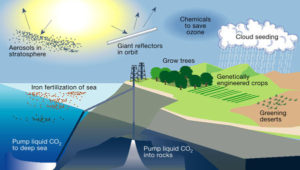Current efforts to mitigate and adapt to climate change might not succeed in time to avoid dangerous consequences. One option to fight climate change—often discussed within scientific circles, but still relatively unknown among the general public—is solar radiation management (SRM), a type of geoengineering that reflects some short-wave radiation (such as ultraviolet radiation or sunlight) into space. SRM is an artificial extension of natural processes, like cloud layers and ice caps, which similarly reflect some of the sun’s heat back into space. SRM could also reduce the Earth’s mean temperature, but the technology raises concerns.
 A group of researchers, including Erb Institute Faculty Director Joseph Árvai, set out to study public perceptions of this technology in different countries, and their findings were published in Climatic Change—“Beliefs and Values Explain International Differences in Perception of Solar Radiation Management: Insights from a Cross-Country Survey,” by Vivianne H.M. Visschers, Jing Shi, Michael Siegrist and Joseph Árvai.
A group of researchers, including Erb Institute Faculty Director Joseph Árvai, set out to study public perceptions of this technology in different countries, and their findings were published in Climatic Change—“Beliefs and Values Explain International Differences in Perception of Solar Radiation Management: Insights from a Cross-Country Survey,” by Vivianne H.M. Visschers, Jing Shi, Michael Siegrist and Joseph Árvai.
SRM involves spraying sulfate particles into the stratosphere to reflect sunlight. Despite potential ecological side effects, SRM would be much easier and cheaper for some countries—even companies—to implement than carbon dioxide removal, another geoengineering option, because it is already within their technological capabilities, and its effects might be more immediate. At the same time, SRM could be weaponized, even by the world’s poorer countries or non-state actors, altering weather and climate for geopolitical gain.
Because SRM’s side effects are not well understood, and its use will cross national boundaries, the researchers surveyed people in Canada, China, Germany, Switzerland, the U.K. and the U.S. to find out:
- how much perceptions of SRM differ among people from different countries
- to what extent certain factors explain people’s acceptance of SRM:
- perceived risks associated with SRM
- concern about climate change
- altruistic, egoistic and biospheric values
- the belief that SRM tampers with natural processes
- the notion of “moral hazard” (the idea that SRM would make people less motivated to address rising greenhouse gas emissions)
Participants in the study read a description of SRM’s purpose, mechanisms, benefits, risks, uncertainties and sustainability. Then they answered questions about the values and perceptions above.
Public acceptance
The study revealed relatively high levels of acceptance of SRM across the board. In all six countries, concern about climate change was associated with greater acceptance of SRM. This suggests that, “as people are more worried about the consequences of climate change, the perceived need for a wide range of strategies—including SRM—for dealing with it is higher,” the researchers wrote.
Canadian and U.S. respondents revealed significantly less favorable views of SRM than the Chinese, German and Swiss respondents. Overall, perceptions of SRM’s high risk and stronger beliefs that SRM interferes with nature were consistently linked to lower acceptance.
 Tampering with nature
Tampering with nature
Tampering with nature was the most important predictor of SRM acceptance in Canada, Germany, Switzerland and the U.K. It was less important in China.
The strong relationship indicates that “emphasizing the artificiality of SRM is likely to solidify public opposition, independent of individuals’ valuation of nature and the ecosystem.” So the idea of tampering with nature is important in assessing public acceptance of SRM in western countries.
The idea may be less important in a country like China, “because these participants may have had more experience with geoengineering (e.g., weather modifications in Beijing) than did participants from the other countries,” the researchers wrote.
Moral hazard
Based on previous research, stronger beliefs that SRM would pose a moral hazard might have been expected to make SRM less acceptable, the researchers said. The moral hazard of SRM is that, because the technology can reduce global temperatures on its own, there would be no reason to address the root human cause of climate change: greenhouse gas emissions. But they found the opposite: Stronger beliefs that SRM would cause a moral hazard were related to greater acceptance in every country except Switzerland.
“It could be that concerns about the consequences of climate change usurped similar concerns about moral hazard, perhaps because people, including members of the scientific community, increasingly believe that drastic measures to address global warming are needed to prevent irreversible effects of climate change when other climate mitigation policies appear ineffective,” the researchers wrote.
Egoism
Stronger egoistic values were consistently linked to greater SRM acceptance. The researchers explained: “This observation makes sense, in that people who are more inclined to focus on themselves are generally less willing to change their behavior in order to benefit others; because SRM is a technological (vs. behavioral) fix, it does not require changes on a personal level.”
The relationship between egoism and support for SRM was stronger in Canada and the U.S., which the researchers said may be “because technologies that are self-enhancing (i.e., technological fixes that address problems without requiring fundamental changes in personal or firm-level behavior) appear to be more acceptable in North-American cultures than they are in Northern-European and Asian cultures.” They pointed to nanotechnology and genetically modified food as examples.
Altruism
The researchers did not find a strong link between altruism and SRM acceptance. Altruism increased acceptance only in China, Switzerland, the U.K. and the U.S. The lack of a strong association suggests that people who support SRM do not necessarily do so to help others.
Biospheric values
Biospherism is characterized by a sense of unity with, and concern for, nature, and the survey found that biospheric values were inversely related to SRM acceptance. The researchers noted that people with strong biospheric values may see SRM as tampering with nature, so the relationship between nature tampering and SRM acceptance may overshadow the relationship between biospherism and acceptance.
Differences among countries
Most previous research focused on western, industrialized countries. In this survey, the Canadian respondents perceived greater risk than those in China, Germany and Switzerland did. Because higher perceived risk predicted lower acceptance, Canada’s higher risk perceptions may explain the lower levels of support for SRM there.
The U.S. respondents were less concerned about climate change than their counterparts were, and their belief that SRM would pose a moral hazard was weaker. “Hence, American respondents may have been less convinced of the need for a technology such as SRM to combat climate change and were, therefore, less supportive of this technology,” the researchers noted.
Chinese respondents were more accepting of SRM, and their belief that SRM tampers with nature was lower than those of respondents elsewhere. But their belief that SRM presents a moral hazard was significantly higher than the other countries’ respondents. Chinese respondents “worried more that [SRM’s] deployment would hinder mitigation efforts aimed at the root causes of climate change. These findings are in line with previous findings regarding moral hazard . . . and, in our view, are a reflection of competing concerns in China,” including prioritizing economic growth and concerns about air quality, the researchers wrote.
Economically challenged nations have less capacity to limit or reduce their greenhouse gas emissions than highly industrialized countries do. Because of economic and social inequalities, people from these countries consider climate change more dangerous than their counterparts in more affluent countries. This disparity might explain the Chinese respondents’ more positive opinion of SRM, and this and previous research suggests that “people from countries that are less prepared to mitigate and adapt to climate change seem to be more supportive of SRM,” the researchers noted.
Implications
The researchers argue that the general public must be consulted about SRM’s acceptability, and that decision-making about SRM should be an internationally inclusive process, as it will require a long-term commitment from the international community.
And the study offers insight in dealing with public perception. “Pointing people to the risks of irreversible climate change will increase support for SRM, even to people who feel that this technology interferes with nature,” they wrote. Also, because people may not associate many benefits with SRM, risk communication should stress these benefits, such as rapidly stabilizing many of the harmful environmental, social and economic consequences of climate change.